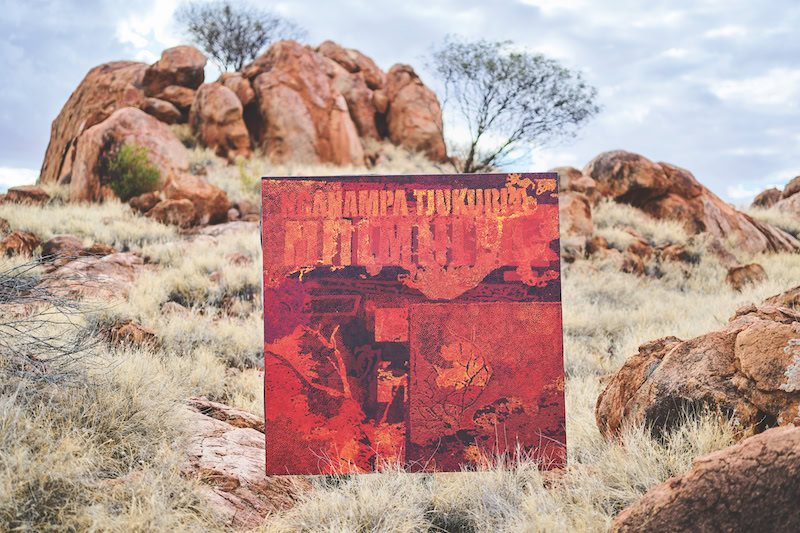One may well ask, “What can’t he do?”, when examining the scope of Robert Fielding’s practice. Working across photography, sculpture, painting, printmaking, installation, and notably salvaging, Fielding has recently added glass to his wide-ranging oeuvre, inspired by a residency at Canberra Glassworks in mid-2023.
For the past 26 years, Fielding has been based in Mimili, a small Aṉangu community south of Mparntwe, in the Aṉangu Pitjantjatjara Yankunytjatjara Lands (APY Lands). A major concern for the artist is the preservation of the Mimili Tjukurpa (Dreaming), and through his art he aims to share the importance of these stories. The “grand masters”, or Elders, of Mimili have allowed Fielding to represent the community throughout his artwork. His strong cultural connections and contemporary practice enables him to confidently move across mediums to push aesthetic boundaries in central desert art.
Fielding, of Pakistani, Afghan, Western Arrente and Yankunytjatjara descent, “sleeps and dreams art”. Working at Mimili Maku Arts, an Aṉangu-owned art centre in Mimili, he spends his day experimenting with new techniques and materials. While maintaining a steady focus on his own daily practice, Fielding is also a key mentor for emerging artists and staff in the studio. Even after closing time at the art centre, the artist will go out on long trips with his wife Kaye, collecting objects, stories and memories that will eventually be encapsulated into his artwork.
Always returning to his main foundation and inspiration, Mimili, Fielding uses the scavenged items collected across Country to draw on memory that is held within the object, and within the owner’s past and present. His use of found objects is a fundamental aspect of his practice, acting as a bridge to his people and their shared connection to Country;
“Our people, our spirit, our languages, our song and dance are all expressions of the sacredness of this earth,” he said when his work was exhibited in The National 4 (a biennial survey of contemporary Australian art) in 2022. “This sacredness radiates through my Elders, in everything they do, everything they are, everything they create…My work is a reminder of that sacred interconnectedness, miil-miilpa.”
Fielding has been a practising artist for over two decades and has exhibited nationally and internationally for the past ten years. For the 4th National Indigenous Art Triennial, Ceremony, the National Gallery of Australia commissioned Holden on, 2021-22. A Holden car, painted up in designs, was presented on a pontoon on Lake Burley Griffin for the duration of the Triennial. The work identifies the need for cars in remote communities and the critical accessibility roles vehicles have for those living there.
Fielding also incorporates the car wrecks into his photographic work, often exposing his photographs on Country using the sun. From February-April this year, Kinara pulka irnyani palyanu. Tjintungku kampara utinu. (The big moon shone brightly and made. The sun burnt through and brought it out) – which includes his work Graveyards In Between – is at John Curtin Gallery as part of the Perth Festival.
His intimate and magnetic photographs feel as if they’re glowing from the inside. Capturing Mimili through a contemporary lens, he uses the unwanted and abandoned to make us feel connected to the place, even if we haven’t spent time on Country. Fielding’s work has a knack for drawing the viewer in to feel at one with the work.
/ Fielding’s work has always been about restoring what was lost. But with these experiments, he is looking to the future. / ERIN VINK
Fielding is currently working towards his solo show at Canberra Glass Works which runs from 9 May to 27 July 2024. He is the first artist from Mimili to create work in glass. Co-curated by Erin Vink, curator, First Nations art at AGNSW, and Aimee Frodsham, artistic director, Canberra Glassworks, the exhibition will be a result of his artist-in-residence 2023 commission. Fielding has spent his time at Glassworks experimenting and learning the tricks of the trade with a variety of glass production techniques. He has worked with other molten materials before, such as bronze casting, but this will be his first significant body of work with glass.
Vink notes that during the artist-in-residence, Fielding focused on the year his father – part of the stolen generation – was born, 1927. “Fielding’s work has always been about restoring what was lost,” says Vink. “But with these experiments, he is looking to the future.”
Fielding’s upcoming exhibition at Canberra Glass Works is likely to be one of his most exciting to date. The wonder of how he will combine his existing use of found objects and installation with glass will be a novel revelation. One thing for sure is that integral to the work will be the spirit of his community and his Country. The spirit of Mimili.
Above: Robert Fielding with a major work at Mimili Maku Arts. This work will show in Fielding’s solo exhibition at Maitland Regional Art Gallery in late 2024. Courtesy: the artist and Mimili Maku Arts.





